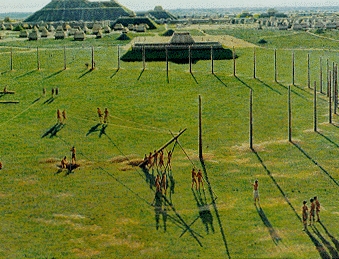 Central Cahokia Mounds, Collinsville, IL
From: J. M. Faragher et al., 2000, Out Of Many: A History of The American People (NJ: Prentice Hall), page xlviii.
http://www.geocities...558/mound1.html
Who Were the Mound Builders?
Central Cahokia Mounds, Collinsville, IL
From: J. M. Faragher et al., 2000, Out Of Many: A History of The American People (NJ: Prentice Hall), page xlviii.
http://www.geocities...558/mound1.html
Who Were the Mound Builders?
Most people are aware of the great civilizations of Egypt and Mexico, but few, even American Indians themselves, realize there were great civilizations in North America as well.
Simply put, the Mound-Builders were American Indians. The civilizations that flourished here were spectacular in their own right and are known as the Mound-Builders incorrectly. The Mound-building took place over many hundreds of years and was practiced by many different groups. Remember we are talking about nations here. Saying Indians is like saying Europeans. Just as German and English cultures are very different, so are the Nations of Amerindians. Another thing the reader should realize is American Indians call themselves American Indians, NOT Native Americans. Mound building in one form or another flourished from 3000 B.C. until the mid 19th century and there were many different Native Americam cultures that built mounds. Thus, the term Mound-Builder is an innaccurate term. Cahokia Mounds ( another mis-named place as the Cahokia Indians were part of the Illiani Indians and were not the group that had occupied Cahokia Mounds ) in Illinois is representitive of the height of the Mississippian Culture Civilization in North America that reached it's peak around 1450 A.D. although it lasted well into the 18th century with the Natchez. Other forms of mound building lasted well into the late 19th century.
Credit has been given to almost every race on earth for the building of mounds. From the time the first settlers arrived rigth up to the present almost every race on earth has been considered as originators of this culture. Even when the true originators, the American Indian, were found to be the creators of this phase it would not be long before racism and romanticism would prevail and once again the theories would abound to answer the question,"Who built the mounds?" The purponents of these wildly speculative theories ignore things like the fact that many of the groups in the Americas pre-date those of the Old World. For example, Cahokia was a flourishing population center and a city in every sense of the word when London was a few scattered huts. There were domesticated plants being put to use, as the Koster site shows, when the Sumerians and Egyptians were still fledgeling civilizations, or not even established.
The fact is, however, the Mound Cultures were made up of many different cultures that shared cultural traits. There were also many phases of Mound Culture civilization practiced by almost all known Amerindain groups at some time and spanning eons. The hight of American Romanticism with the Mound Cultures peaked in the 19th century and it is at this time that Congress, in deciding on grants to the Bureau of Ethnology (today known as the Smithsonian Institute) decided that the question of who had built the mounds should be settled once and for all.
In 1881 the Congress of the United States gave $5000 to the Smithsonian Institution to conduct archeological excavations relating to the prehistoric Mound Builders and prehistoric mounds. Mr. Wills de Haas of Wheeling, West Virginia, was placed in charge of the project. Mr. de Haas who had studied Grave Creek Mound at Moundsville, West Virginia, resigned after a year. He was replaced by Cyrus Thomas and the project continued until 1890. The goal of the mound explorations was to settle the question of who were the Mound Builders. Were they an ancient vanished race as many scholars believed or were they the ancestors of the American Indians. By the completion of the project in 1890, over 2000 mounds and earthworks had been studied in the eastern United States. About 100 of these were in the Kanawha Valley. In 1894 Cyrus Thomas published his book Report on the Mound Explorations of the Bureau of Ethnology and proved that the Mound Builders were not a vanished race but the ancestors of the American Indian. This was the birth of modern American Archeology. Once the question of the identity of the Mound Builders was settled, archeologists began tracing the development of North American Indian culture.
Today the term Mound Builder is missused.
The types of mounds built, although many and varied, can be divided into two basic culture types. These two basic types are usualy called Effigy and Temple and both groups as well as many Amerindian groups that did not belong to these two groups, practiced making various forms of burial mounds and cairns. Other types of mounds, such as burial, are varied in type to the extent as to warrant their own sub-groups.
A third form, probably the most famous, are called effigy mounds. This latter type includes sites such as the Serpent Mound on Ohio and other effigy mound groups. These sites often include other forms of mounds and earth-works and take many forms including birds.
Sometime around 6000 B. C., while Neolithic farming began in the Near and far East, it also began in North America. Several sites in North America show established settlements and farming occurring as early as 7000 B.C. Now, I know your thinking, "This is the New World," but the fact is that the Koster Site in Illinois, and Annis Shell Mound in Kentucky show unmistakeable agricultural pratices in the heart of North America during these times. There are indications that some of these sites are older still. In fact recent dates indicate some forms of agriculture as early as 10000 BC. Today, over 50% of the worlds domesticated produce comes from plants domesticated by the Amerindian.
Mound building is believed to have begun as a burial practice, the mound serving as both tombstone, tomb and offering site to the deceased. However, what is believed to be the oldest known mound complex in the Americas dates to about 3400 B.C., and shows no indication of any ceramonial purpose whatsoever. The mound group is near Monroe in northern Louisiana. This site demonstrates that the idea of mound culture developement being dependant on agricultural developement is an inaccurate one as the builders of this complex were hunter/gatherer cultures according to present studies on the site. This site further demonstrates that the oral traditions of my ancestors are not as trivial as many archaeologists believe them to be.
Later the practice of mound-building and earthworks grew into several basic and distinct types. The burial mound, the effigy Mound, and the temple or platform mound. Although the Effigy form is considered to be the older than the temple form and as such appears first in most books on the subject, the Platform mound is actually older. The earliest of these are found in Meso-America among the remains of the Olmec culture. It is here that we can see the development of mound building. The Olmec began with earthen platform mounds then began paving these mounds with stone until finally all their structures of this type were made of cut stone.
It is the earthen platform mound found in North America that characterizes the Mississippian period that began around 400 A. D.
© 1995 1997 1998 1999 2000 by Hutchison Research Center.












































































